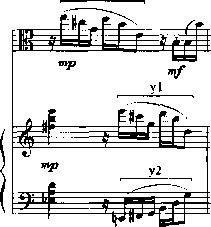121
Although motive x is the most prevalent motive in the movement, partly due to its
frequent fragmented appearances,62 it is never presented in its entirety in the piano part.
This is not the case for the opening gesture (motive y), which is initially presented by the
viola, but developed later in the movement by both instruments. This two-part figure,
shown in Example 3.11, begins with alternating major thirds and tritones (y1) and ends
with an ascending scale (y2).
Example 3.11: Viola Sonata, First mvt., mm. 1-2, viola only, motive y
yl ι,________________∑2

Motive y is often used as an introduction to motive x, sometimes appearing in a
fragmented form as shown below in Example 3.12. Here, the viola and the right hand of
the piano reiterate motive y1 while simultaneously the left hand of the piano echoes the
modal ascending scale, y2.
Example 3.12: Viola Sonata, First mvt., mm. 7-8, overlapping of motive y

Figure 9 outlines the reoccurrences of motive y throughout the movement:
62 This fragment is made up of the last four notes of motive x and occurs in the viola part
in m. 20, 31, 34, 38, 39, 40, 93, 94, and 95 and the piano part in m. 11, 32, 34-35, 37, 45,
87, 89, and 92.
More intriguing information
1. Place of Work and Place of Residence: Informal Hiring Networks and Labor Market Outcomes2. Solidaristic Wage Bargaining
3. Artificial neural networks as models of stimulus control*
4. Strategic Effects and Incentives in Multi-issue Bargaining Games
5. The name is absent
6. The name is absent
7. A Brief Introduction to the Guidance Theory of Representation
8. Moffett and rhetoric
9. The migration of unskilled youth: Is there any wage gain?
10. AN EMPIRICAL INVESTIGATION OF THE PRODUCTION EFFECTS OF ADOPTING GM SEED TECHNOLOGY: THE CASE OF FARMERS IN ARGENTINA